A gorgeous gaming monitor so glossy I can see myself really liking it
It may have changed names, but the glossy Dough Spectrum 4K gaming monitor is a glorious thing.

The Eve Spectrum 4K display is one of my favourite gaming monitors. The crowdsourced screen was built by committee and all the better for it. It may have taken a while to get off the ground and out the factory door, and suffered by connection to the Eve tablet fiasco, but the company has moved on from shipping the product itself to stocking it at major distributors all over the place.
Bright, crisp, and delivers the sort of deep blacks you don't normally see on an IPS panel. And it looks beautiful.
And now it's gone glossy. Eve first announced the move earlier this year, again in response to user requests, and I've been testing one on my desk for a little while now. And it's even more glorious than its matte black predecessor.
Most gaming monitors use a standard matte finish over their panels in order to better disperse the light and avoid unwanted reflections ruining the experience. But they have their downsides, too, with the potential for delivering a more hazy image and not being quite so crisp in terms of contrast.
The new glossy version of the Eve Spectrum 4K 144Hz screen, on the other hand, is bright, crisp, and delivers the sort of deep blacks you don't normally see on an IPS panel. And it looks beautiful.

Screen size: 27-inch
Aspect ratio: 16:9
Native resolution: 3840 x 2160 (4K)
Pixel density: 163ppi
Brightness: 450cd/m2 typical, 750cd/m2 peak
HDR: HDR10 | VESA DisplayHDR 600
Colour depth: 8-bit + A-FRC
Response time: 5ms GtG typical
Refresh rate: 144Hz
Adaptive sync: NVIDIA G-SYNC Compatible certified | AMD FreeSync Premium Pro certified
Backlighting: Bottom edge-lit | 16-zone dimming (HDR mode)
Ports: 2x HDMI 2.1, 1x DisplayPort 1.4, 1x USB Type-C (video, 100W power, USB hub), 1x USB Type-B (USB hub), 1x USB Type-C, 2x USB Type-A, 3.5mm audio jack
Speakers: No
Price: $1,099 (plus $99 for stand)
I mean, I was always a fan of the bright LG panel the company used for its freshman gaming monitor, but now it's gone back to the factory for its glossy finish, it looks even better. Eve, sorry Dough, had to wait for LG, as the panel manufacturer, to do the hard work delivering the new coating, as it's not as simple as just slotting a bit of glass over the front of the screen.
Internal parts, such as the polarizer, had to be changed, and that wasn't something Dough itself could do.
Yeah, sorry, I should explain the Dough thing as a quick aside. It's irrelevant when it comes to this lovely screen, but it's a whole new thing. Basically, Eve is no longer. Apparently, as a global brand, and one going through another round of financing, it needs a name it can trademark, and 'Eve' it cannot. Why Dough?
Keep up to date with the most important stories and the best deals, as picked by the PC Gamer team.
I honestly can't bring myself to type the tripe trotted out as to why it chose the name, so I'm just going to copy/paste it here in the name of expediency and you can make your own jokes about how awful the squishy new brand name is.
"In a way, creating the ultimate gaming hardware is like making bread. Mixing the same essential ingredients, but the outcome depends on baker’s skill. Same at DOUGH, we take the community’s feedback, combine it with resources from our suppliers, and voila – the ultimate baguette product that moves the kneadle needle."
Yeeeeaaaahhh.

Anyways, back to the screen. It still has all the same expanded functionality of its matte brethren, so there's the USB Type-C dock, which allows for Alt DisplayPort functionality as well as providing 100W of power the other way, a good-looking stand, and a bright 750cd/m² peak luminance.
Now, the image on screen also looks crisper, with deep contrast levels that can really make a scene pop. It looks gorgeous in-game, and the 144Hz refresh rate means that it still flows well at the 4K resolution, too.
In short, I'm sold on glossy. And so are millions of creative types, otherwise Apple wouldn't have been glossing over its iMacs for years.
Then, Dough is also now charging Apple prices, too. The glossy finish adds another $150 to the cost of the Spectrum 4K, which brings it to $1,099. And that's without the $99 stand. Again, very Apple. $1,200 is a huge amount of cash for a 27-inch 4K 144Hz screen, however pretty it is, and that really makes it a tough screen to recommend on any kind of value footing.

But what about those reflections? Admittedly, if you're in a bright office and can't control the overhead illumination there's a chance you could get some distracting reflections, maybe if you're digging through the decay in Resident Evil Village, for example. But the screen is so bright that even then you've got a good chance of overpowering it.
And if you can control the lighting—y'know, in your own home—then you can always draw the curtains, right?
For me, the reflections aren't an issue and a very small price to pay for the enhanced visual experience the glossy panel delivers. The actual financial price to pay isn't so small, however, which is a major concern, though also why the company is trying to sort out more distribution channels.
If you're hankering for a bright, rich, colourful 4K screen, there are few as good. Otherwise, I'm going to struggle to recommend you spend $1,200 on it—and have difficulty calling it the Dough Spectrum 4K monitor—but I'm going to enjoy every moment gaming on this thing.

Dave has been gaming since the days of Zaxxon and Lady Bug on the Colecovision, and code books for the Commodore Vic 20 (Death Race 2000!). He built his first gaming PC at the tender age of 16, and finally finished bug-fixing the Cyrix-based system around a year later. When he dropped it out of the window. He first started writing for Official PlayStation Magazine and Xbox World many decades ago, then moved onto PC Format full-time, then PC Gamer, TechRadar, and T3 among others. Now he's back, writing about the nightmarish graphics card market, CPUs with more cores than sense, gaming laptops hotter than the sun, and SSDs more capacious than a Cybertruck.

